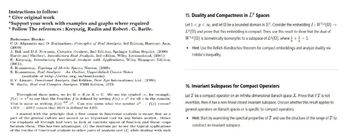
Algebra & Trigonometry with Analytic Geometry
13th Edition
ISBN: 9781133382119
Author: Swokowski
Publisher: Cengage
expand_more
expand_more
format_list_bulleted
Question

Transcribed Image Text:Instructions to follow:
* Give original work
"Support your work with examples and graphs where required
* Follow The references: Kreyszig, Rudin and Robert. G. Bartle.
Reference Books:
C.D. Aliprantis and O. Burkinshaw, Principles of Rea! Analysis, 3rd Edition, Harcourt Asia,
(2000)
J. Bak and D.J. Newman, Complex Analysis, 2nd Edition, Springer Indian Reprint, (2009)
Bartle and Sherbert, Introductory Real Analysis, 3rd edition, Wiley International, (2001).
E. Kreyszig, Introductory Functional Analysis with Applications, Wiley Singapore Edition,
(2001).
S. Kumaresan, Topology of Metric Spaces, Narosa, (2005).
S. Kumaresan, Real Analysis An Oulline, Unpublished Course Notes
(available at http://mtts.org.in/downloads)
B.V. Limaye, Functional Analysis, 2nd Edition, New Age International Ltd., (1996).
W. Rudin, Rcal and Complex Analysis, TMH Edition, 1973.
Throughout these notes, we let K = R or K = C. We use the symbol, for example,
f(x) to say that the function f is defined by setting f(x) = for all in the domain.
This is same as writing f(x) 2. Can you guess what the symbol x2f(x) means?
def
LIIS RIIS means that RIIS is defined by LIIS.
I started with the principle that a first course in functional analysis is meant first as a
part of the general culture and second as an important tool for any future analyst. llence
the emphasis all through had been to look at concrete spaces of function and linear maps
between them. This has two advantages: (1) the students get to see the typical applications
of the results of functional analysis to other parts of analysis and (2) while dealing with such
15. Duality and Compactness in IP Spaces
Let 1 <p< ∞, and let 2 be a bounded domain in IR". Consider the embedding I: W¹º(S) →
LP() and prove that this embedding is compact. Then, use this result to show that the dual of
W¹P(S) is isometrically isomorphic to a subspace of L4(2), where += 1.
Hint: Use the Rellich-Kondrachov theorem for compact embeddings and analyze duality via
Hölder's inequality.
16. Invariant Subspaces for Compact Operators
Let I be a compact operator on an infinite-dimensional Banach space X. Prove that if I' is not
invertible, then it has a non-trivial closed invariant subspace. Discuss whether this result applies to
general operators on Banach spaces or is specific to compact operators.
⚫ Hint: Start by examining the spectral properties of T and use the structure of the range of T to
construct an invariant subspace.
Expert Solution
This question has been solved!
Explore an expertly crafted, step-by-step solution for a thorough understanding of key concepts.
Step by stepSolved in 2 steps with 4 images

Knowledge Booster
Recommended textbooks for you
- Algebra & Trigonometry with Analytic GeometryAlgebraISBN:9781133382119Author:SwokowskiPublisher:Cengage
 Big Ideas Math A Bridge To Success Algebra 1: Stu...AlgebraISBN:9781680331141Author:HOUGHTON MIFFLIN HARCOURTPublisher:Houghton Mifflin Harcourt
Big Ideas Math A Bridge To Success Algebra 1: Stu...AlgebraISBN:9781680331141Author:HOUGHTON MIFFLIN HARCOURTPublisher:Houghton Mifflin Harcourt

Algebra & Trigonometry with Analytic Geometry
Algebra
ISBN:9781133382119
Author:Swokowski
Publisher:Cengage

Big Ideas Math A Bridge To Success Algebra 1: Stu...
Algebra
ISBN:9781680331141
Author:HOUGHTON MIFFLIN HARCOURT
Publisher:Houghton Mifflin Harcourt